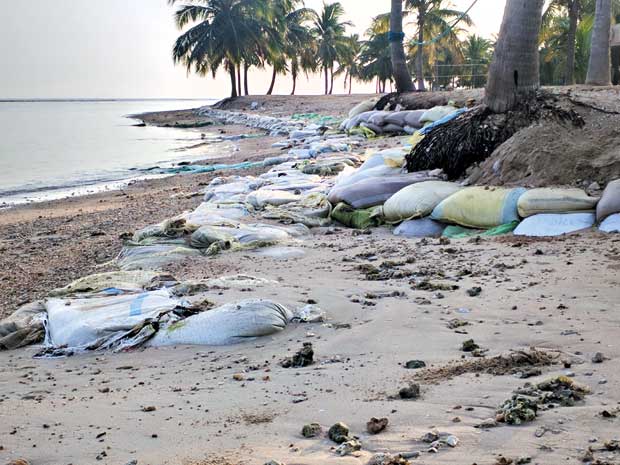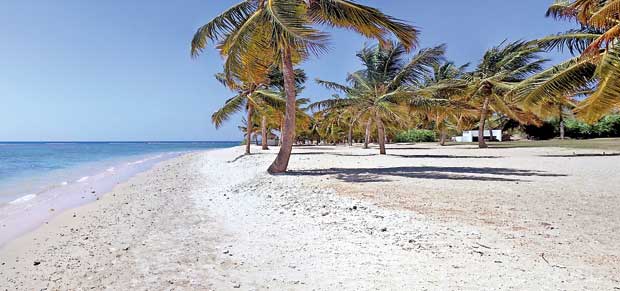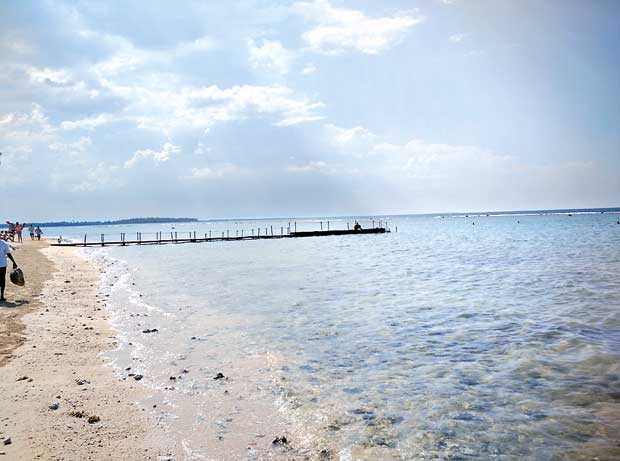Reply To:
Name - Reply Comment
 Picture A
Picture A
The Pasikuda beach, which has delighted both foreign and domestic tourists since the Eastern Coast of Sri Lanka opened up to the world with the conclusion of the 25-year long civil war, seems to be facing bouts of non-seasonal sea erosion.
From March through November during its peak season, the calm and quaint bay which is protected by a wall of corals, drives tourists in droves towards it, with its over 500 rooms being fully-booked when the season hits full swing in August.
However, from November through March, during the North-East monsoon, the beach is constantly battered by rough waves as water levels rise above the influence of the corals. Embankments created with bags full of broken corals—which are common in Pasikuda and do not wash away like bags of sand—are a common sight, as hoteliers in the worst hit parts of the bay attempt to stave off  the waves that advance the shoreline by around 15-20 metres during these months.
the waves that advance the shoreline by around 15-20 metres during these months.
However, two successive visits to Pasikuda over the span of two weeks between July and August bore witness to a changing landscape.
Picture ‘A,’ taken during the closing day of the United Nations World Tourism Conference that was held in July, shows a beach that could contest with the best beaches in the world—albeit only in beauty, as this most picturesque section of Pasikuda beach is filled with corals, and tourists have to walk several hundred metres to find a safer and more comfortable bathing spot.
However, a visit in early August saw the very same section of the beach with a receded shoreline, embankments of coral bags, and coconut trees, with their roots exposed, almost about to collapse, if not for the support from the embankments (Picture ‘B’).
One of the hotels in the worst hit stretch of the beach had set up embankments up to the edge of its swimming pool.
 Picture B
Picture B
The locals—who had, during the civil war engaged in fishing activities despite crackdowns against fishing by both the Liberation Tamil Tigers Eelam as well as the Sri Lanka Army during their respective periods of control of the region—are pointing their fingers towards the big hotels that have cropped up over the last five years, perhaps in an act of biting the hand that feeds. The hotels have created plenty of employment opportunities for locals, and created spaces for locals owning boats to set up water sports businesses.
A group of locals told Daily Mirror that the hotels were attempting to clear their sections of coral-filled beaches by digging the corals out, in order to let their tourists enjoy the beach closer to the hotels.
Meanwhile, One Group Level Executive from an entity listed on the Colombo Stock Exchange pointed the finger at one of his competitors.
“They have created this concrete jetty, and that’s what’s causing this, just like in Unawatuna,” the top-level corporate said under the condition of anonymity.
In order to combat coastal erosion in Unawatuna, the government had constructed a breakwater without conducting proper research, which had resulted in the eastern section of the beach eroding at a faster rate, with the sand washed away from there being deposited in the western side.
In Pasikuda, the alleged culprit had constructed a jetty extending a few metres into the sea as seen in Picture ‘C,’ which allowed its guests to walk over the section of corals to jump into clearer water.
“I do not think these people constructed it by getting the proper approval,” the Executive further charged.
When inquired if the Coastal Conservation Department (CCD) was aware of the problem, the executive speculated that the department may not even be aware of it.
However, when CCD Area Engineer Sakuntha Pathmasiri was contacted, he said the department was aware of the problem for the past two years, and that it was not caused due to any construction.
“The hotels came in during the past 4-5 years. The erosion has been happening since before that. It just wasn’t noticed until the hotels came in, because it didn’t impact anyone. During the monsoon, there is a 10-15 metre seasonal loss,” he said.
However, when inquired as to why erosion was happening during August and if the government was planning to do anything about it, Mr. Pathmasiri was not very convincing with his reply.
“A net loss can be there, but it is not significant. We are not looking at doing anything right now because it is not that serious,” he said.
However, judging from the sentiments of hoteliers as well as tourists, the situation arising during the peak season does appear to be a serious concern.
Mr. Pathmasiri stated that the government had several options available if the situation gets out of hand.
“For tourism zones, the best solution is pumping in sand, but that costs around Rs. 800 million per kilometre. We have done that in Marawila and Unawatuna. If not, we can even put in stone walls but that destroys tourism. We are still monitoring. We have been monitoring over the past couple of years, and we will continue to monitor the situation,” he said.
 Picture C
Picture C
However, another theory that has also emerged among interested parties about the unusual erosion is that the wall of corals protecting Pasikuda from large waves during the calmer months is being damaged due to excessive tourism activities, which may be a possibility considering extensive research undertaken into similar situations in other countries.
Motorboats and speedboats operate within the bay from dawn to dusk, ferrying tourists to and from popular snorkelling and diving sites, while tourists also rent jet skis and speedboats to constantly whizz across the bay or to pull water skiers or banana boats, releasing a large amount of fumes, noise and constantly changing wave patterns, which are cited by research studies as causes of damage to coral formations.
Snorkelers have also noted the presence of fallen makeshift anchors—mainly large concrete bricks with frayed or damaged rope—on the corals, while the shallowness of the snorkelling sites lead to amateur snorkelers standing on the corals and boats damaging the corals with regular, metal anchors.
A number of studies conducted recently have also led to the findings that global warming contributes not merely to rising ocean levels due to ice cap melting, but also to the bleaching of corals that protect the shores from waves.
Whatever the reasons are for the unusual sea erosion seen during the peak tourism season in Pasikuda, what is clear is that the ‘finger-pointing’ will continue.